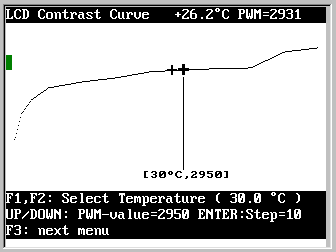(only available for certain programmable terminals)
Instructions for the LCD contrast (curve-) editor
See also:
The LCD used in the following terminals...
...needs a very careful, and temperature-dependent control of the display
contrast.
Internally, a DC voltage is applied to the LCD's backplate. We will call it "contrast voltage" in this document. The contrast voltage is generated by the microprocesser through a pulse-with-modulator ("PWM", acts like a digital-to-analogue converter here). The PWM's mean output level depends on the temperature of the display. Unfortunately the relation between display temperature and optimum LCD contrast voltage is very non-linear, so we need a kind of lookup-table. There are a few "reference points" for this relation stored in an internal EEPROM which you *may* have to modify if the LCD contrast is not optimal in a certain temperature range. These "reference points" can be edited on a special screen located somewhere in the terminal's system/setup menu.
sys.edit_contrast)The next chapter will show you how to do this.
After opening the LCD contrast editor, you will see a screen like this (at least, it will be similar as the screenshot shown below).
 (snapshot "LCD contrast")
(snapshot "LCD contrast")
The upper text line show the currently measured temperature and the interpolated PWM value for that temperature (which produces the LCD contrast voltage). The current temperature is also marked by a small cross on the curve.
The currently selected reference point is marked with larger cross and a vertical line, the "numeric coordinates" of this point are displayed below the vertical line (here: 30°C, and the PWM-Value). To modify the LCD contrast voltage at this temperature, use the rotary button (which replaces the CURSOR UP/DOWN key on certain terminals). Turning the knob increases or decreases the PWM value of the reference point, and -if the point is close to the current temperature- you will immediately notice the effect on the LCD's contrast. The stepwidth or the UP/DOWN function can be altered with the ENTER key (there are certain terminals which don't have and ENTER key... press the rotary button in this case, which is a replacement for a real ENTER key.
The contrast curve should be monotonic increasing. If not, you must also modify the left or right "neighbour" of the edited reference point. To switch to the previous or next reference point, use the function keys F1 and F2. (There are certain terminals where the function keys are not labelled, in that case "F1" is "the upper or the leftmost key", and F2 is the next key below F1 or right of it..)
If you are satisfied with the new contrast curve, you must save it permanently. Use the "SAVE and EXIT" option for this. If you don't see such an option in the menu area, press the F3 key until a menu appears with this option. There may be more functions in the LCD contrast editor than those mentioned here.
If you opened the editor from the terminals "System Menu", there will be more functions than if the editor was invoced from the "terminal application" with a special interpreter command.
See main manual.